Hudson River Almanac 11/24/2018 - 11/30/2018
The New York State Department of Environmental Conservation sent this bulletin on 12/07/2018 02:00 PM EST |
| DEC Delivers - Information to keep you connected and informed from the NYS Department of Environmental Conservation |
| Share or view as a web page || Update preferences or unsubscribe |
|
Compiled by Tom Lake, Hudson River Estuary Program Consulting NaturalistOverviewWe have a different sort of Highlight of the Week this time, and I must admit, I have a weakness for entries where a songbird makes a reader’s heart sing. As in this entry, the evening grosbeak was the bird of the week. Across the watershed, it appeared that an evening grosbeak “irruption” was occurring. [An irruption is a dramatic and irregular southern movement of large numbers of birds to areas where they are not found most years, often far from their normal range. For the evening grosbeak, it means a southward shift of their normal Canadian winter range. Stan DeOrsey] Highlight of the Week
[Roger Tory Peterson describes the evening grosbeak (Coccothraustes vespertinus) as a chunky, short-tailed finch the size of a starling with a large conical bill. Their native range includes the coniferous forests of Canada and northern U.S. Males are a contrast of bright yellow, black, and white, while females are more subdued with grays and browns. Tom Lake] Natural History Entries11/24 – Hudson River Watershed: The season has arrived when we should give some serious thought to our wildlife viewing and photographing habits. Cold weather can be especially challenging for birds. They run on a strict energy budget, balancing calories-in with calories-out, instinctively adhering to a conservation of energy. Every time we flush a winter bird by trying to get closer, or employ audio lures to draw them in, the calories needed for them to move depletes their reservoir. If they are near evening roost time, they will need to replenish in order to keep their furnaces stoked all night. “Getting closer” should be much more a function of our optics – scopes, zoom lenses, and binoculars – than our legs. 11/24 – Saratoga County, HRM 182: We did a circuit around Saratoga Lake this afternoon. While there were no unusual species of note, the total numbers of several species were impressive, including a conservative estimate of 600 common goldeneye, 200 each of common and hooded mergansers, and a flock of 500 snow geese. I'm not sure I've ever seen hooded mergansers in such a huge concentration like that. Notable by their absence were loons, grebes, and cormorants. 11/24 – Kingston Point, HRM 92: Among the birds we saw at Kingston Point today were two uncommon “winter gulls”: an Iceland gull (Larus glaucoides) and a glaucous gull (Larus hyperboreus). Also, found there among the common mergansers, common goldeneyes, ring-billed and herring gulls, was a white-winged scoter.
[The state of Massachusetts and the Canadian province of Quebec use gold bands on their bald eagles. Previously, nearly all of the gold-banded eagles we have seen in the Hudson Valley have been wintering birds from Massachusetts. Tom Lake]
11/24 – Manhattan, HRM 7: My family and I were driving north on Manhattan’s West Side Highway in midday when we saw a huge bird gliding along not more than 40 feet above the traffic. It was low tide on the river – a good hunting tide for eagles – and, sure enough, the bird had an American eel in its talons. It was absolutely breathtaking to see this beautiful mysterious creature flying over Manhattan. 11/25 – Beacon, HRM 61: The tide was extremely high, perhaps from the few-days-ago full moon, as well as all the rain and early-season melting snow. Four hours into my fishing session, I still had not had a single bite. I began to wonder if the season was over. Then, the fish showed up and in the last two hours I caught and released five channel catfish (2 - 5 pounds). Everyone at Long Dock Park was treated to an adult bald eagle perched in a red oak, riverside at the end of the point. 11/25 – Rockland County, HRM 31: Of the 40 raptors we counted today at the Hook Mountain Hawkwatch, 31 were a mix of immature and adult red-shouldered hawks – an impressive showing. Some came in small wave-lets, 3-4 at a time. Non-raptor observations included a red admiral butterfly in mid-afternoon at the summit when the air temperature was likely near its peak for the day. 11/26 – Town of Wappinger, HRM 67: A lesson in humility is always a good thing. Coming back from our check of the riverfront, we found our road home totally impassible. Wild turkeys, 29 of them, were slowly heading up the road, spanning it from side-to-side. They were in no hurry. Most were young-of-year with a much smaller contingent of adults, a couple of which were serving as rear guard. I was glad that no other vehicles were around to test another driver’s patience. While it was no more than a few minutes, it seemed like much longer before the adults herded the younger birds off the road and into a field. It was a forced relaxation that helped us rearrange our priorities.
[About 4,000 years ago, the first of us living in the Northeast made a series of small, stone spear or dart points that archaeologists have stylistically-labeled the Narrow-stemmed Tradition, of which the Bare Island was one. These pre-ceramic, pre-bow-and-arrow technology Indians were likely Algonquian-speakers, perhaps ancestral to the people who met the first Europeans more than 2,000 years later. They were mobile hunters, gatherers, fishers and foragers. Other than analyzing their stone tools, we know very little else about them. The dating of stone artifacts is tricky. For projectile points (“arrowheads”) we often rely on the accuracy of radiocarbon dating (C14) of organic material found in association with stone tools to arrive at an approximate date. Discoveries like these of long-ago artifacts help define the great time-depth of the Hudson Valley and put a face on an ancient human occupation. Tom Lake] 11/26 – Verplanck, HRM 40.5: We spotted our first non-resident bald eagle of the season, an immature, in a tree in Verplanck. It perched for quite some time, eying a single snow goose, before taking flight. The snow goose was at Waterfront Park where it had been foraging for several days and seemed to have a voracious appetite. I wondered if it was left behind from some of the large flocks that have passed over. 11/26 – Manhattan, HRM 1: We checked our research sampling gear in Hudson River Park at The River Project's sampling station on the lighthouse tender Lilac at Pier 25 and found a small mix of fish and crustaceans including an adorable 43 millimeter (mm) skilletfish and two young-of-summer blue crabs (125, 175 mm). [Note: one inch = 25.4 millimeters (mm)]
[Moose (Alces alces) are the largest extant member of the deer family (Cervidae) and are native to the boreal forests of the Northern Hemisphere. Bulls, up to six-feet-high at the shoulder, can weigh up to 1,200 pounds, with cows to 800 pounds. When Europeans arrived more than 400 years ago, moose were common. Biologists estimate that there are about 400 moose in the greater Adirondacks region today with far fewer found elsewhere in the watershed. Moose are not normally aggressive. However, they can be when hungry, tired or harassed by people, pets, and vehicular traffic. Tom Lake]
[The lined seahorse (Hippocampus erectus) is a small to palm-sized fish that swims in an upright position, looking much like the Knight in a game of chess. They are poor swimmers as fish go and use their prehensile tail to wrap around stationary objects to maintain their place in the face of strong currents. Male sea horses are notable for their brood pouch in which they carry fertilized eggs deposited by the females. In one of the rare instances in the animal kingdom, it is the males that give live birth. Tom Lake] 11/28 – Indian Point, HRM 42: In late October, 1982, I was fishing for striped bass in front of the warm-water discharge at the Indian Point power generating facility. I was finding no bass, so I picked up a light spinning rod with a small silver Little Cleo lure. Before long, I had caught a ladyfish (14-inches), three crevalle jacks (6-inches), and three Atlantic needlefish. My reasoning at the time was that the dropping river temperature had the tropical fishes seeking a warm-water refuge and finding it in the outflow from the power plant. [Bob Vargo Sr. read our Almanac entry from 10/29, reminiscing about a ladyfish (Elops saurus) caught on rod-and-reel at Danskammer Point in late October 1982. The point of that entry was the rarity of this tropical species in the Hudson River. Bob offers an addendum: His ladyfish may have coincided with the 10/29 catch. Tom Lake] 11/29 – Kingston, HRM 92: A large flock of about three dozen birds passed over my yard in late afternoon. While I did not get a good look at them, their diagnostic rattling flight call and then their tight formation had me thinking they were Bohemian waxwings. They circled back and then headed west. [True to their name, Bohemian waxwings wander like bands of vagabonds across the northern United States and Canada in search of fruit during the nonbreeding season. High-pitched trills emanate from the skies as large groups of these songbirds descend on fruiting trees and shrubs at unpredictable places and times. They occasionally stray into our area. All About Birds] 11/29 – New Hamburg, HRM 67.5: On May 16, bald eagle nest NY459A was destroyed by ferociously storm winds that included tornadoes elsewhere in the lower Hudson Valley. A pair of 42-day-old nestlings fell out of the nest and had to be rescued and transported to the Delaware Valley Raptor Center where they recovered. Five months later, the breeding pair had fully re-built the nest. Today was the most recent example of seeing both adults in and around the nest, sometimes bringing new materials. Dana Layton, among other nest-monitors, has photographed the pair side-by-side in a tree adjacent to the nest. Prospects for 2019 seem good. I have often thought that a picture of a bald eagle should appear in the dictionary, under the word “resilient”. 11/29 – Rockland County, HRM 31: There was just a single high-flyer red-tailed hawk at the Hook Mountain Hawkwatch today, migrating southwest. Non-migrants included four turkey vultures, two ravens, and one red-tailed hawk cruising here-to-there and back again. I also spotted an immature bald eagle headed northeast. 11/30 – Greene County, HRM119: A dozen evening grosbeaks, nine males and three females, showed up at my feeders today in South Cairo. This was very exciting because I had never seen them here before. Thanks for letting me share my good fortune! 11/30 – Bethel, Sullivan County: I was so excited to see the evening grosbeaks at my feeders today! The last time I saw an evening grosbeak was about eight years ago and then just for a few days. Today, they wiped out the black oil sunflower seed and then flew away. I quickly replenished the feeders and hope they return. While I am hoping for evening grosbeaks, I am wary of black bears. Two nights ago, at midnight, we had a bear at our bird feeder. [Bethel is in Sullivan County just outside the watershed. However, birds have wings and they do fly, so a little stretching of the boundary seemed appropriate. Tom Lake] [The DEC released a Guidance to Homeowners on how to avoid problems with black bears.
Autumn 2018 Natural History ProgramsTBA Hudson River Miles DEC's Smartphone app for iPhone and Android is now available at: New York Fishing, Hunting & Wildlife App. Adventure NYUnder Governor Cuomo's Adventure NY initiative, DEC is making strategic investments to expand access to healthy, active outdoor recreation, connect more New Yorkers and visitors to nature and the outdoors, protect natural resources, and boost local economies. This initiative will support the completion of more than 75 projects over the next three years, ranging from improvements to youth camps and environmental education centers to new boat launches, duck blinds, and hiking trails. Read more about the Adventure NY initiative. For more information on planning an outdoor adventure in New York State, visit DEC's website at http://www.dec.ny.gov/outdoor. |

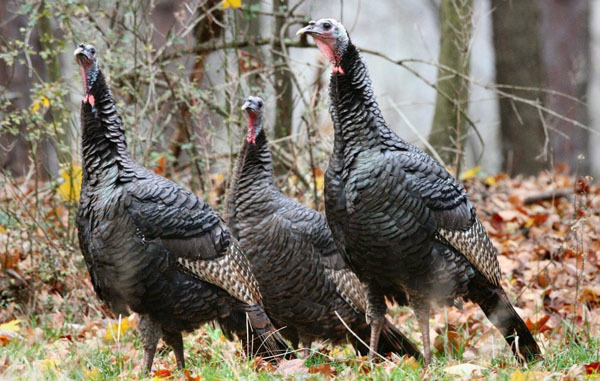 Hudson River Almanac
Hudson River Almanac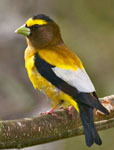 11/30 – Town of Fishkill, HRM 63: Early this morning, I watched as a flock of evening grosbeaks came in and made my heart sing! I was surprised and so delighted to see them since I had never found them here before. This year, I added a platform feeder to my backyard that holds shelled peanuts, sunflower chips, and a fruit and berry mix, and the birds were feeding heartily. I knew they were likely migrating, but I hoped they would return tomorrow. (Photo of evening grosbeak courtesy of E.J. Peiker)
11/30 – Town of Fishkill, HRM 63: Early this morning, I watched as a flock of evening grosbeaks came in and made my heart sing! I was surprised and so delighted to see them since I had never found them here before. This year, I added a platform feeder to my backyard that holds shelled peanuts, sunflower chips, and a fruit and berry mix, and the birds were feeding heartily. I knew they were likely migrating, but I hoped they would return tomorrow. (Photo of evening grosbeak courtesy of E.J. Peiker)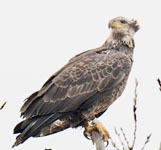 11/24 – Kingston Point, HRM 92: While on a John Burroughs Natural History Society Field Trip, we spotted a banded immature bald eagle. The light was poor, and the bird was not close. I had difficulty determining the band color, but I think it may have been gold. The banded bird ended up going after an adult that had a fish. Later, we watched a merlin unsuccessfully chase feral pigeons.(Photo of banded bald eagle courtesy of Deborah Tracy-Kral)
11/24 – Kingston Point, HRM 92: While on a John Burroughs Natural History Society Field Trip, we spotted a banded immature bald eagle. The light was poor, and the bird was not close. I had difficulty determining the band color, but I think it may have been gold. The banded bird ended up going after an adult that had a fish. Later, we watched a merlin unsuccessfully chase feral pigeons.(Photo of banded bald eagle courtesy of Deborah Tracy-Kral) 11/24 – Town of Poughkeepsie, HRM 67.5: For Bill Lenhart’s flying squirrel entry (11/10), we guessed at the time that it may have been a northern flying squirrel (Glaucomys sabrinus). John Kent (Hudson-Mohawk Bird Club) suggested that it may have been a southern flying squirrel (G. volans). After checking the literature, we agree, that given their range in New York State, it was more likely to have been a southern flying squirrel. (Photo of flying squirrel courtesy of Bob Rightmyer)
11/24 – Town of Poughkeepsie, HRM 67.5: For Bill Lenhart’s flying squirrel entry (11/10), we guessed at the time that it may have been a northern flying squirrel (Glaucomys sabrinus). John Kent (Hudson-Mohawk Bird Club) suggested that it may have been a southern flying squirrel (G. volans). After checking the literature, we agree, that given their range in New York State, it was more likely to have been a southern flying squirrel. (Photo of flying squirrel courtesy of Bob Rightmyer)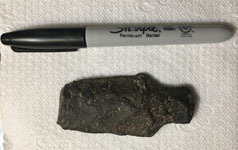 11/26 – Orange County, HRM 46: Tom Hall remembers when his dad worked on a farm in the Black Dirt region of Orange County near Pine Island. One day, his dad found an interestingly flaked stone in a furrow and kept it as a curiosity. With a little investigation, Tom now knows its pedigree. The three-inch-long stone tool with a broken tip, is a biface – worked on both sides – and is what archaeologists call a projectile point. In reality, this tool may have served a multitude of practical uses as a spear point, hide scraper or, if hafted onto a wooden handle, a knife. The point was fashioned from a type of stone called chert. While “typing” prehistoric stone tools is an inexact science, certain physical attributes suggested that this one is what archaeologists call a Bare Island point from the Late Archaic Period, named for its type site at Bare Island, on the lower Susquehanna River in Pennsylvania. (Photo of Bare Island projectile point courtesy of Tom Hall)
11/26 – Orange County, HRM 46: Tom Hall remembers when his dad worked on a farm in the Black Dirt region of Orange County near Pine Island. One day, his dad found an interestingly flaked stone in a furrow and kept it as a curiosity. With a little investigation, Tom now knows its pedigree. The three-inch-long stone tool with a broken tip, is a biface – worked on both sides – and is what archaeologists call a projectile point. In reality, this tool may have served a multitude of practical uses as a spear point, hide scraper or, if hafted onto a wooden handle, a knife. The point was fashioned from a type of stone called chert. While “typing” prehistoric stone tools is an inexact science, certain physical attributes suggested that this one is what archaeologists call a Bare Island point from the Late Archaic Period, named for its type site at Bare Island, on the lower Susquehanna River in Pennsylvania. (Photo of Bare Island projectile point courtesy of Tom Hall)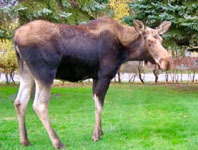 11/27 – Columbia County, HRM 113: In mid-morning, I spotted a cow moose as it ambled off a road in Hillsdale and headed east into the woods. I followed it a short distance – the moose was in no hurry. It looked back at me, and then disappeared into the forest. I asked some of my neighbors if they had ever seen a moose around here, but no one had. (Photo of cow moose courtesy of Brian Sweig)
11/27 – Columbia County, HRM 113: In mid-morning, I spotted a cow moose as it ambled off a road in Hillsdale and headed east into the woods. I followed it a short distance – the moose was in no hurry. It looked back at me, and then disappeared into the forest. I asked some of my neighbors if they had ever seen a moose around here, but no one had. (Photo of cow moose courtesy of Brian Sweig)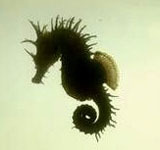 11/27 – Manhattan, HRM1: We recently captured a lined seahorse (60 mm) in our collection gear in Hudson River Park at The River Project's sampling station on the lighthouse tender Lilac at Pier 25. Seahorses are rather uncommon relative to other fishes we catch; we see a half-dozen each year. (Photo of lined seahorse courtesy of Cathy Drew)
11/27 – Manhattan, HRM1: We recently captured a lined seahorse (60 mm) in our collection gear in Hudson River Park at The River Project's sampling station on the lighthouse tender Lilac at Pier 25. Seahorses are rather uncommon relative to other fishes we catch; we see a half-dozen each year. (Photo of lined seahorse courtesy of Cathy Drew) 11/30 – Town of Wappinger, HRM 67: On a chilly day, we found a banded woolly bear caterpillar inching-along on the warm, dark macadam. The woolly bear is the larval form of the Isabella tiger moth (Pyrrharctia isabella). This caterpillar had three bands, from fore-to-aft: black-brown-black. We thought of the old, but perhaps not entirely discredited, belief that the wider the middle rusty-brown section, the milder the coming winter will be. Conversely, the wider the black sections, the more severe the winter. Our woolly bear was dominated by its middle brown section (13 mm), flanked by lesser black sections (10, 8 mm). If we were inclined to believe, we would expect a mild winter. (Photo of wooly bear caterpillar courtesy of Tom Lake)
11/30 – Town of Wappinger, HRM 67: On a chilly day, we found a banded woolly bear caterpillar inching-along on the warm, dark macadam. The woolly bear is the larval form of the Isabella tiger moth (Pyrrharctia isabella). This caterpillar had three bands, from fore-to-aft: black-brown-black. We thought of the old, but perhaps not entirely discredited, belief that the wider the middle rusty-brown section, the milder the coming winter will be. Conversely, the wider the black sections, the more severe the winter. Our woolly bear was dominated by its middle brown section (13 mm), flanked by lesser black sections (10, 8 mm). If we were inclined to believe, we would expect a mild winter. (Photo of wooly bear caterpillar courtesy of Tom Lake)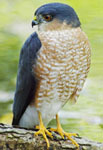 11/30 – Brooklyn, New York City: My “autopilot” was firmly engaged, and I barely noticed arriving at my usual exit off the Belt Parkway on my morning commute. Suddenly, streaking in from the north, over the Flatbush Avenue exit, a sharp-shinned hawk made a determined stoop at a mixed flock of starlings and pigeons. A dozen birds were thrown into a frenzy, one or two literally rolling onto the road's pavement, perhaps knocked over by the hawk’s surprise attack. Several birds, including the hawk, just barely cleared the oncoming cars. I hadn't appreciated how close to breakfast that sharpie had been until a second or two later, my car coasted through a flurry of loose feathers, undoubtedly ripped from the underparts of some very lucky survivor. In the distance, an empty-handed hawk banked and landed on a roadside tree, undoubtedly resetting its trap. (Photo of sharp-shinned hawk courtesy of Alan Kolnik)
11/30 – Brooklyn, New York City: My “autopilot” was firmly engaged, and I barely noticed arriving at my usual exit off the Belt Parkway on my morning commute. Suddenly, streaking in from the north, over the Flatbush Avenue exit, a sharp-shinned hawk made a determined stoop at a mixed flock of starlings and pigeons. A dozen birds were thrown into a frenzy, one or two literally rolling onto the road's pavement, perhaps knocked over by the hawk’s surprise attack. Several birds, including the hawk, just barely cleared the oncoming cars. I hadn't appreciated how close to breakfast that sharpie had been until a second or two later, my car coasted through a flurry of loose feathers, undoubtedly ripped from the underparts of some very lucky survivor. In the distance, an empty-handed hawk banked and landed on a roadside tree, undoubtedly resetting its trap. (Photo of sharp-shinned hawk courtesy of Alan Kolnik)